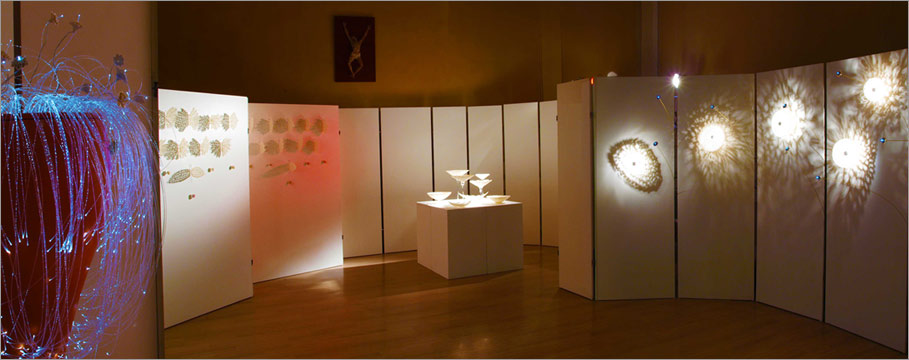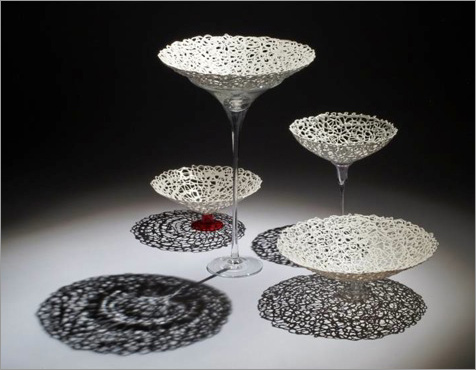 Our relationship with Antonella Cimatti was based on coincidences. Last year Manuela and I noticed one of her paperclay works, a crespina on a tall glass stem, on a design magazine and took a mental note of the name of the artist.
Our relationship with Antonella Cimatti was based on coincidences. Last year Manuela and I noticed one of her paperclay works, a crespina on a tall glass stem, on a design magazine and took a mental note of the name of the artist.
On a one day trip to Faenza during the Summer I tried to contact Antonella but she was out of town… Almost accidentally, however, I visited a temporary exhibition at the Mic where I was fascinated by her ceramic and light installation.
In November we went to visit a ceramic art exhibition at the Ab Ovo Gallery in Todi and we saw (and touched, with the permission of the Gallery owner…) two of her crespine.
A couple of weeks later Antonella sent us an email to establish a contact with us. The circle was closed!
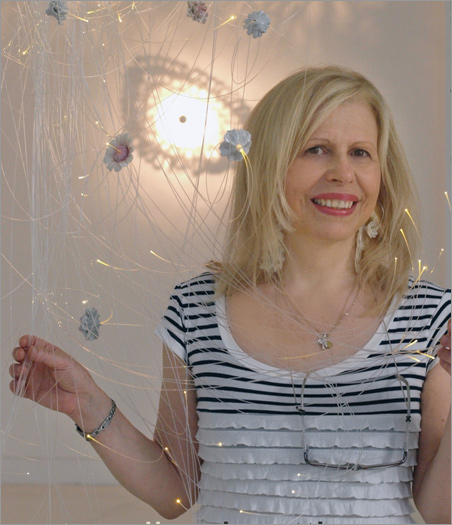 Antonella Cimatti’s artistic path is extremely rich. Born in Faenza, where she still lives, she studied with Carlo Zauli, one of the most important artists of the 20th century. Since her graduation in Fine Arts in Bologna, she has been constantly experimenting new techniques and mediums, with a keen interest in design.
Antonella Cimatti’s artistic path is extremely rich. Born in Faenza, where she still lives, she studied with Carlo Zauli, one of the most important artists of the 20th century. Since her graduation in Fine Arts in Bologna, she has been constantly experimenting new techniques and mediums, with a keen interest in design.
We interviewed her a few days ago.
TIPJ: Antonella, reading your CV, Manuela and I were very much impressed by the large number of activities, studies and experiences you’ve been through. A short summary for our readers:
– internships abroad to study different techniques relating to pottery making, decoration and design;
– design projects with leading glass and ceramic companies
– participation to experimental art movements
– ceramic exhibitions, camps and contexts all over the world
Last, but not least, you have been teaching at the State Art Institute of Ceramics Ballardini since 1979. It really looks like you are “hungry” to learn and experiment. What is the drive behind your multiple activities?
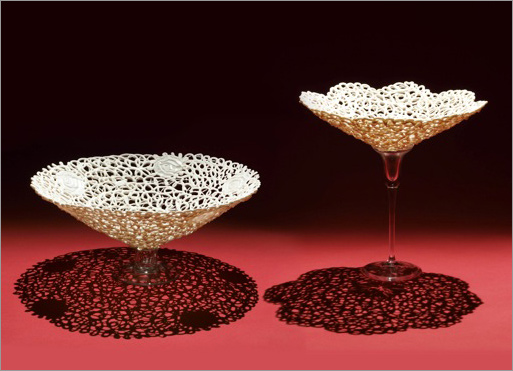 A. Cimatti: I believe that a major commitment for an artist is to always keep up to date professionally. Indeed spontaneous creativity must without exception be complemented by high standards of professional competence in technique, technology and in the interpretation of contemporary art: first reading and observing, then the pleasure of testing, combining and confirming.
A. Cimatti: I believe that a major commitment for an artist is to always keep up to date professionally. Indeed spontaneous creativity must without exception be complemented by high standards of professional competence in technique, technology and in the interpretation of contemporary art: first reading and observing, then the pleasure of testing, combining and confirming.
That’s why I’ve always been fascinated by experiments. It all started when I was a student, around ’75 and I tested the fusion of Murano glass mosaics on ceramic sheets and plates.
This is a technique that I later applied on larger ceramic panels, published by Nino Caruso in his book “Ceramic decoration”, and also on majolica during the 80’s. I made small diptychs and politychs and I decorated them with pearls and glass filaments for the exhibitions of the art group “The new ceramic” (La Nuova Ceramica), curated by Franco Solmi and Marilena Pasquali.
TIPJ: An accurate conceptual study and a close attention to design trends are common elements in all your collections. Do you consider yourself more of an artist or a designer?
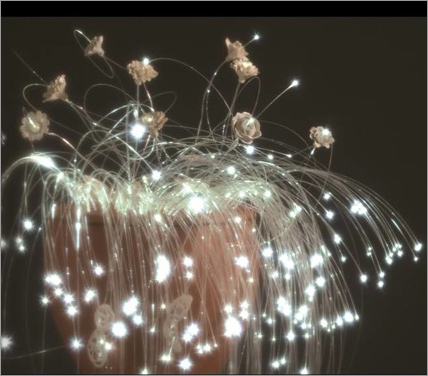 A. Cimatti: Yes, my work is suspended between art and design, so I could say I’m interested in both. However, I’m much more attracted to the world of design that nowadays is more and more artistic, unique and precious: think about the one-of –a-kind pieces and the best in class collections that are featured in art galleries.
A. Cimatti: Yes, my work is suspended between art and design, so I could say I’m interested in both. However, I’m much more attracted to the world of design that nowadays is more and more artistic, unique and precious: think about the one-of –a-kind pieces and the best in class collections that are featured in art galleries.
TIPJ: What are the respective roles of tradition and experimentation in your work?
A. Cimatti: My planning starts from a new point of view on the artistic production of the past, filtered through my personal, formal sensitivity aimed to build a functional or sculptural object. My motto is to run experiments starting from tradition and, if possible, to go further.
TIPJ: From our portfolio, it appears that you’ve been devoting most of your creative energies to ornamental art works. Do you find decoration more inspirational than functional design?
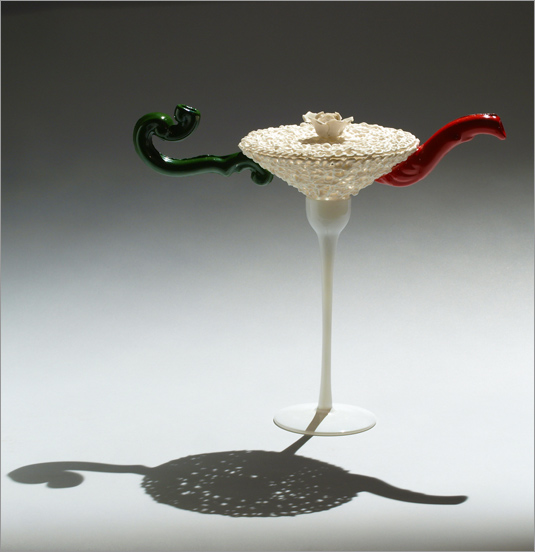 A. Cimatti: Yes, indeed. I like working at decorative objects better because they have a role in a given space, they embellish and add to it, they establish a relationship, engage the user.
A. Cimatti: Yes, indeed. I like working at decorative objects better because they have a role in a given space, they embellish and add to it, they establish a relationship, engage the user.
For example, I made some tea pots that are not functional at all. They are designed to evoke the smell of tea. Objects that stimulate emotions and memories, that act as catalysts for experiences and, in some way, encourage dreams.
But of course when I design light installations, in addition to the decorative and sculptural effect of light, there is the added value of functionality.
TIPJ: We are very much fascinated by your Crespine, complex miracles of lightness. They look like a tribute to Faenza pottery tradition… are they?
A. Cimatti: Yes, the Crespine were finely shaped majolica bowls made in Faenza around the 16th and 17th century which entered European royal courts as luxury items. In 2005 I started revisiting the bowls for a new collection of porcelain paperclay objects. It’s been very exciting and also very challenging to work on traditional shapes with a brand new philosophy and technique.
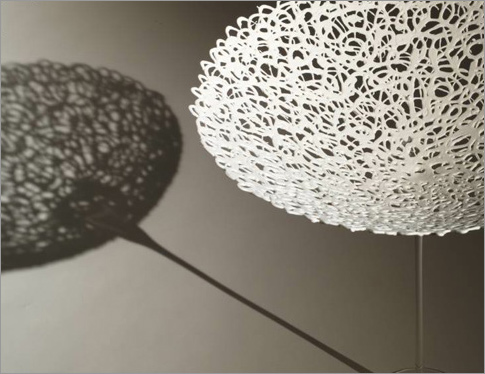 My Crespine are large bowls made of ceramic filigree, a kind of lace woven with a precious porcelain thread: a result that can be achieved only with paperclay. They are airy, light, vulnerable objects that live out of light and shadows.
My Crespine are large bowls made of ceramic filigree, a kind of lace woven with a precious porcelain thread: a result that can be achieved only with paperclay. They are airy, light, vulnerable objects that live out of light and shadows.
This collection represents a new way of interpreting the matter, not as a physical matter, but as an evocative transparency.
TIPJ: Can you explain how you make your Crespine? We saw a picture where you look like a chef decorating a cake…
A. Cimatti: The bowls are made of a thin and light filigree that after the firing becomes self supporting: it’s the art of adding instead of cutting out pieces of clay like in the original Crespine from the Renaissance, where the fretwork patterns were carved out of a solid piece of clay.
With the aid of a syringe, the paperclay is shaped free-handedly on a concave or convex refractory support and is then kiln fired at high temperature. Sometimes the bowls are installed on blown glass supports, designed and molded in Tuscany. In my work, I indulge in round shapes, that were very popular in Renaissance architecture.
TIPJ: If you were to outline your artistic evolution thru your collections, which ones would you focus on?
A. Cimatti: I’d like to focus on the last six years. In addition to the Crespine, I wish to mention the Sinus Fluentes collection and the light installations.
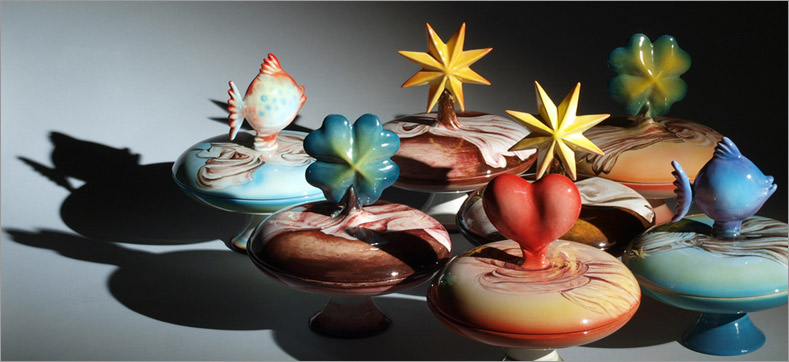 The Sinus Fluentes collection was designed in 2005, in cooperation with Laura Silvagni. The painstaking work on the shades of color, based on the traditional majolica decoration, perfectly embraces the subject: draperies and folds that look like knots or flowers.
The Sinus Fluentes collection was designed in 2005, in cooperation with Laura Silvagni. The painstaking work on the shades of color, based on the traditional majolica decoration, perfectly embraces the subject: draperies and folds that look like knots or flowers.
The collection aims to renew the traditional pottery motifs while using the traditional techniques from Faenza.
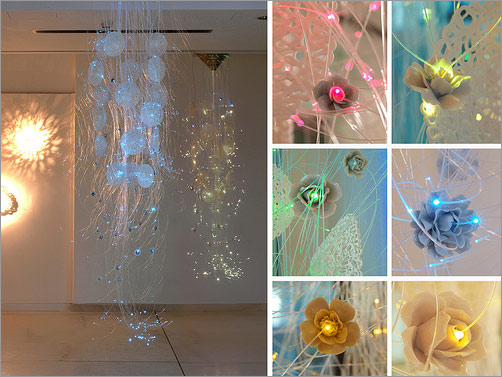 Recently I’ve been working with porcelain to make large installations. They are environmental sculptures that produce light thanks to optical fiber technology: the light plays with porcelain and, getting into its gaps and holes, creates new shapes. Thus the ceramic loses its body and weight to become flexible and dynamic. The space comes to life and a closely woven set of optical illusions surfaces from the dark.
Recently I’ve been working with porcelain to make large installations. They are environmental sculptures that produce light thanks to optical fiber technology: the light plays with porcelain and, getting into its gaps and holes, creates new shapes. Thus the ceramic loses its body and weight to become flexible and dynamic. The space comes to life and a closely woven set of optical illusions surfaces from the dark.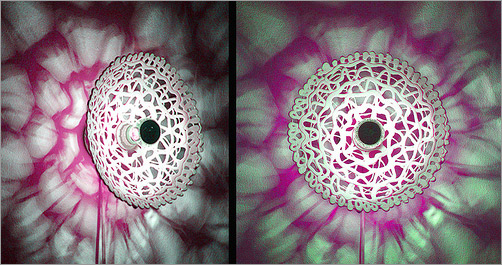
TIPJ: We perceived in your collections, almost without exception, a strong feminine touch. How does your womanhood contributes to your art?
A. Cimatti: As I wrote in the catalog of the exhibition “The women’s design” in 1991, in my work I’ve never tried to conceal or betray my womanhood.
TIPJ: Nature is a constant presence in your work. Sometimes you quote it, sometimes you reinterpret it, but it’s always there. Why is it so important to you?
A. Cimatti: Nature embraces everything: harmony, beauty, balance, color.
TIPJ: One question about Faenza, definitely a landmark for Italian pottery art, design and innovation. In Italy the resources behind art and culture have unfortunately been decreasing over time. We heard rumors that also the MIC and the Art Institute have been negatively impacted. What is being done to preserve the local heritage and Faenza leading role in ceramic art?
A. Cimatti: All the institutions in Faenza are in agreement with the need to preserve our heritage and act accordingly. The Art Institute, too, is working to offer new programs that aim to reposition our tradition into modernity.
TIPJ: What are your future art projects, the ones you can tell us about?
A. Cimatti: I wait to travel, if possible, to get in touch with other art ceramic cultures.
TIPJ: Thank you very much for your time, Antonella. We can’t wait to visit your studio in Faenza, next time we visit your wonderful town.
A. Cimatti: Thank you!!! I’m looking forward to meeting you in Faenza.

